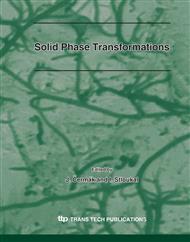[1]
Z.G. Wei, R. Sandstrom and S. Miyazaki: J. Mater. Sci. Vol. 33 (1998), p.3743.
Google Scholar
[2]
J.W. Judy: Smart Mater. Struct. Vol. 10 (2001), p.1115.
Google Scholar
[3]
T.M. Adams, S.R. Kirkpatrick, Z. Wang and A. Siahmakoun: Mater. Lett. Vol. 59 (2005), p.1161.
Google Scholar
[4]
T. Lehnert, H. Grimmer, P. Böni, M. Horisberger and R. Gotthardt: Acta Mater. Vol. 48 (2000), p.4065.
Google Scholar
[5]
V.V. Kudryavtsev, V.V. Nemoshkalenko, Y.P. Lee, K.W. Kim, C.G. Kim and B. Szymanski: J. Appl. Phys. Vol. 88 (2000), p.2430.
Google Scholar
[6]
V.G. Myagkov, L.A. Li, L.E. Bykova, I.A. Turpanov and G.N. Bondarenko: Dokl. Phys. Vol. 47 (2002), p.95.
Google Scholar
[7]
P.L. Potapov, N.A. Poliakova and V.A. Udovenko: Scripta Mater. Vol. 35 (1996), p.423.
Google Scholar
[8]
H.Y. Kim and S. Miyazaki: Scripta Mater. Vol. 50 (2004), p.237.
Google Scholar
[9]
S. Chikazumi: J. Appl. Phys. Vol. 32S (1961), p.81.
Google Scholar
[10]
V.G. Miagkov, L.I. Kveglis, G.I. Frolov and V.S. Zhigalov: J. Mater. Sci. Lett. Vol. 13 (1994), p.1284.
Google Scholar
[11]
E. Ma, C.V. Thomson, L.A. Clevenger and K.N. Tu: Appl. Phys. Lett. Vol. 57 (1990), p.1262.
Google Scholar
[12]
C. Michaelsen, K. Barmak and G. Lucadanno: J. Appl. Phys. Vol. 80 (1996), p.6689.
Google Scholar
[13]
U. Rothhaar, H. Oechsner and M. Scheib: R. Muller, Phys. Rev. B. Vol. 61 (2000), p.974.
Google Scholar
[14]
H. Sieber, J.S. Park, J. Weissmuller and J.H. Perepezko: Acta Mater. Vol. 49 (2001), p.1139.
Google Scholar
[15]
K.J. Blobaum, D. van Heerden, A.J. Gavens and T. P. Weihs: Acta Mater. Vol. 51 (2003), p.3871.
Google Scholar
[16]
A.J. Gavens, D. Van Heerden, A.B. Mann, M.E. Reis and T.P. Weihs: J. Appl. Phys. Vol. 87 (2000), p.1255.
Google Scholar
[17]
K. Barmak, C. Michaelsen and G. Lucadanno: J. Mater. Res. Vol. 12 (1997), p.133.
Google Scholar
[18]
H. Sieber and J.H. Perepezko: J. Mater. Sci. Lett. Vol. 18 (1999), p.1449.
Google Scholar
[19]
A. Taylor and N.J. Doyle: J. Appl. Crystallogr. Vol. 5 (1972), p.201.
Google Scholar
[20]
P.L. Potapov, S.Y. Song, V.A. Udovenko, and S.D. Prokoshkin: Metall. Trans. A Vol. 28 (1997), p.1133.
Google Scholar
[21]
P.L. Potapov, P. Ochin, J. Pons and D. Schryvers: Acta Mater. Vol. 48 (2000), p.3833.
Google Scholar
[22]
D. Alman: J. Mater. Sci. Lett. Vol. 13 (1994), p.483.
Google Scholar


